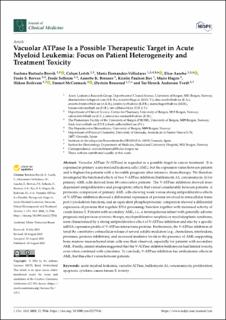| dc.contributor.author | Bartaula-Brevik, Sushma | |
| dc.contributor.author | Leitch, Calum | |
| dc.contributor.author | Valladares, Maria del Carmen Hernandez | |
| dc.contributor.author | Aasebø, Elise | |
| dc.contributor.author | Berven, Frode Steingrimsen | |
| dc.contributor.author | Selheim, Frode | |
| dc.contributor.author | Brenner, Annette | |
| dc.contributor.author | Rye, Kristin Paulsen | |
| dc.contributor.author | Hagen, Marie | |
| dc.contributor.author | Reikvam, Håkon | |
| dc.contributor.author | Mc Cormack, Emmet | |
| dc.contributor.author | Bruserud, Øystein | |
| dc.contributor.author | Tvedt, Tor Henrik Anderson | |
| dc.date.accessioned | 2023-10-10T12:22:57Z | |
| dc.date.available | 2023-10-10T12:22:57Z | |
| dc.date.created | 2023-09-28T09:53:46Z | |
| dc.date.issued | 2023 | |
| dc.identifier.issn | 2077-0383 | |
| dc.identifier.uri | https://hdl.handle.net/11250/3095512 | |
| dc.description.abstract | Vacuolar ATPase (V-ATPase) is regarded as a possible target in cancer treatment. It is expressed in primary acute myeloid leukemia cells (AML), but the expression varies between patients and is highest for patients with a favorable prognosis after intensive chemotherapy. We therefore investigated the functional effects of two V-ATPase inhibitors (bafilomycin A1, concanamycin A) for primary AML cells derived from 80 consecutive patients. The V-ATPase inhibitors showed dose-dependent antiproliferative and proapoptotic effects that varied considerably between patients. A proteomic comparison of primary AML cells showing weak versus strong antiproliferative effects of V-ATPase inhibition showed a differential expression of proteins involved in intracellular transport/cytoskeleton functions, and an equivalent phosphoproteomic comparison showed a differential expression of proteins that regulate RNA processing/function together with increased activity of casein kinase 2. Patients with secondary AML, i.e., a heterogeneous subset with generally adverse prognosis and previous cytotoxic therapy, myeloproliferative neoplasia or myelodysplastic syndrome, were characterized by a strong antiproliferative effect of V-ATPase inhibition and also by a specific mRNA expression profile of V-ATPase interactome proteins. Furthermore, the V-ATPase inhibition altered the constitutive extracellular release of several soluble mediators (e.g., chemokines, interleukins, proteases, protease inhibitors), and increased mediator levels in the presence of AML-supporting bone marrow mesenchymal stem cells was then observed, especially for patients with secondary AML. Finally, animal studies suggested that the V-ATPase inhibitor bafilomycin had limited toxicity, even when combined with cytarabine. To conclude, V-ATPase inhibition has antileukemic effects in AML, but this effect varies between patients. | en_US |
| dc.language.iso | eng | en_US |
| dc.publisher | MDPI | en_US |
| dc.rights | Navngivelse 4.0 Internasjonal | * |
| dc.rights.uri | http://creativecommons.org/licenses/by/4.0/deed.no | * |
| dc.title | Vacuolar ATPase Is a Possible Therapeutic Target in Acute Myeloid Leukemia: Focus on Patient Heterogeneity and Treatment Toxicity | en_US |
| dc.type | Journal article | en_US |
| dc.type | Peer reviewed | en_US |
| dc.description.version | publishedVersion | en_US |
| dc.rights.holder | Copyright 2023 The Author(s) | en_US |
| dc.source.articlenumber | 5546 | en_US |
| cristin.ispublished | true | |
| cristin.fulltext | original | |
| cristin.qualitycode | 1 | |
| dc.identifier.doi | 10.3390/jcm12175546 | |
| dc.identifier.cristin | 2179723 | |
| dc.source.journal | Journal of Clinical Medicine | en_US |
| dc.identifier.citation | Journal of Clinical Medicine. 2023, 12 (17), 5546. | en_US |
| dc.source.volume | 12 | en_US |
| dc.source.issue | 17 | en_US |

